Tina Huckabee hosts a monthly Wildlife meme on the first Wednesday of each month on her lovely My Gardener Says blog. I took part for the first time in January and am just as happy to be able to take part again, this time looking back at the wildlife visiting our garden in February. A month of mixed temperatures, with cold snow, heavy rain and howling winds and then some sunny days rising up to 11c. A wide range of birds, some regulars, some occasional visitors and for the first time a female Black Cap dropped by too, plus a few displaying some unusual behavior.
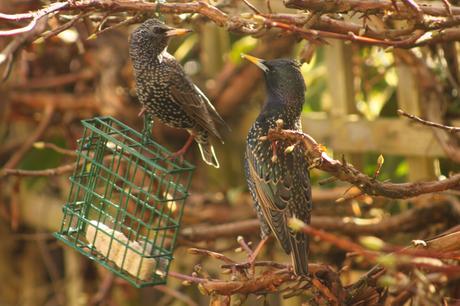
Two Starlings – a mature bird and a juvenile
Running at a right angle to our east facing dining room window is an enormous Hydrangea petiolaris, its a tough woody, shade tolerant climber that provides shelter and foraging opportunities for many birds. In the colder months we add fat blocks impregnated with mealworms and crushed insects to the bare branches. The smaller Starling is a juvenile, its colouring will change and the bird will grow darker feathers. Both birds will lose their spots as they moult and develop darker sleeker feathers in preparation for finding a mate and the breeding season. Starlings regularly nest in a small gap between our barge boards and roof tiles, but to see a whole flock, we travel further east to the Fens between November and February to watch the murmurations.
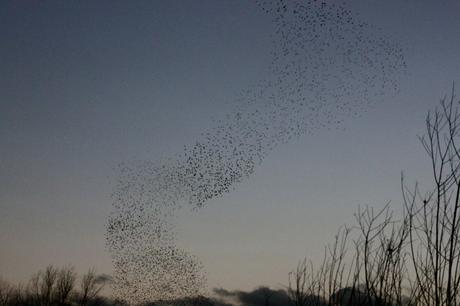
Starling Murmuration at Godmanchester Nature Reserve
Groups of Starlings meet up before dusk, its thought the reason for these gatherings is safety in numbers, predators such as sparrow hawks would find picking off individual birds difficult, to keep warm at night and to exchange information, such as good feeding areas. Watching a murmuration is an exciting event, many thousands of birds, swirling, soaring and finally as dark descends dropping down from the sky to roost.
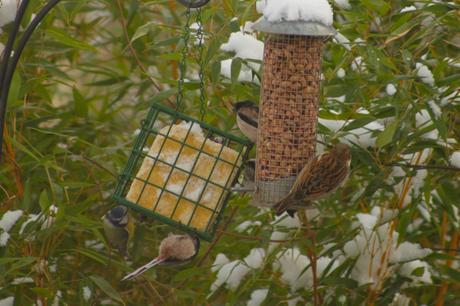
Early February snow, Blue Tits, Long Tailed Tits and female Sparrow,
The month had started with a return to cold snowy weather, a steady stream of birds kept us entertained. The female sparrow was finally joined by a male and increasing numbers of Long tailed Tits came into the garden. This little bird is joyful to watch. The BTO (British Ornithological Trust) reports the success of this little bird and numbers have increased tenfold in recent years, although a very harsh winter could see numbers reduce again.
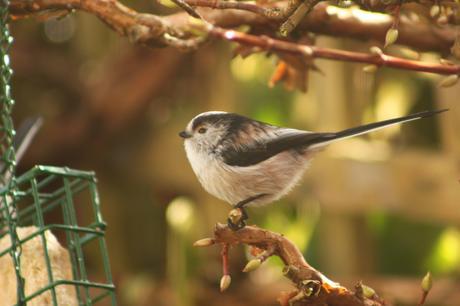
Long Tailed Tit
We encourage as much as we can to visit as a garden is pretty soulless without wildlife and the local pheasants have been interesting to watch as they come in looking for seed dropped from the feeders. They are bred nearby for shooting. The season runs from October 1st to February 1st. Foxes eventually take a lot of those not shot, a neighbor reported 12 in his garden last week, we have 4 hopping in and out, a male and 3 females. They are especially partial to a burnt orange primroses……

Male and Female Pheasant
Last week we watched as the male decided to try and knock seed from the nyger and mixed seed tubes onto the ground. Where there’s a will there’s a way! This unusual behaviour has been reported to the BTO by other bird watchers too. The large black bird on the right is a Jackdaw, they roost with Carrion Crows and Rooks in the nearby woods, making a terrific din.

Pheasant and Jackdaw
On February 16th, we went to a talk by our local Wildlife Trust group on macro moths. We learnt so much, including that one brood of Blue Tit chicks can eat up to 15,000 moth caterpillars. Other birds such as Robins, Wrens and Blackbirds also include moths as a food source. The Butterfly Conservation group estimate our Blue Tit population needs 35 billion caterpillars a year. There are 2,500 species of moths in the UK and most can be found in gardens, one small urban garden may be home to 100 species of Moths. As well as being a food source for other insects, spiders, frogs, toads, lizards, shrews, hedgehogs, bats and birds, they are also a garden pollinator as they feed on plant nectar.
However moths are in decline and the loss has a direct effect on the birds, bats and mammals who depend on them for food. Moth habitat loss is due to intensive farming, changing woodland management and urbanisation. Chemical and light pollution are also reported as having significant effects.
The Butterfly Conservation organisation has an excellent sister site Moths Count and both sites are jam packed with information ranging from identifying tips to citizen science projects.
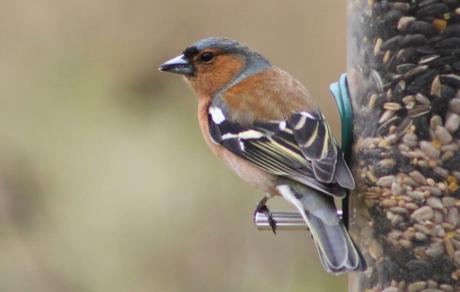
Male Chaffinch
This February we have been visited regularly by a male chaffinch, he will like many other birds be pairing up in the Spring. I read that its the female chaffinch who builds the nest, a neat cup shaped nest in the fork of a tree or tall bush made of lichen and spiders webs and inner layers of moss and grass with a lining of tiny rootlets and feathers and when ready will lay 4 – 5 eggs between late April and June. I haven’t seen her in our garden yet but I hope we do and hope she finds a suitable place to build her nest.
It was national nest box week in February and with the increased loss of suitable natural sites, a nest box put up now may still help garden birds to find a home to lay their eggs. The RSPB has a handy guide should you fancy making a nest box yourself. We have a nest box up with a 25mm entrance hole the suitable size for a Blue Tit, Marsh Tit or Coal Tit.
Please take a look at the other folk taking part in Tina’s Wildlife Wednesday.
Happy Wildlife watching!
